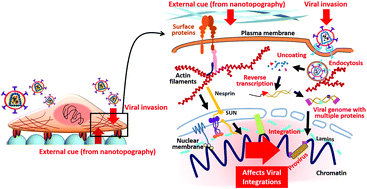Nanotopography-based engineering of retroviral DNA integration patterns†
Abstract
Controlling the interactions between cells and viruses is critical for treating infected patients, preventing viral infections, and improving virus-based therapeutics. Chemical methods using small molecules and biological methods using proteins and nucleic acids are employed for achieving this control, albeit with limitations. We found, for the first time, that retroviral DNA integration patterns in the human genome, the result of complicated interactions between cells and viruses, can be engineered by adapting cells to the defined nanotopography of silica bead monolayers. Compared with cells on a flat glass surface, cells on beads with the highest curvature harbored retroviral DNAs at genomic sites near transcriptional start sites and CpG islands during infections at more than 50% higher frequencies. Furthermore, cells on the same type of bead layers contained retroviral DNAs in the genomic regions near cis-regulatory elements at frequencies that were 2.6-fold higher than that of cells on flat glass surfaces. Systems-level genetic network analysis showed that for cells on nanobeads with the highest curvature, the genes that would be affected by cis-regulatory elements near the retroviral integration sites perform biological functions related to chromatin structure and antiviral activities. Our unexpected observations suggest that novel engineering approaches based on materials with specific nanotopography can improve control over viral events.



 Please wait while we load your content...
Please wait while we load your content...